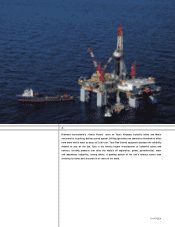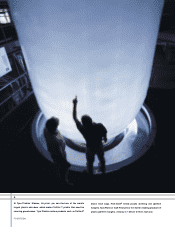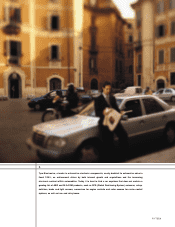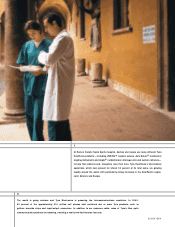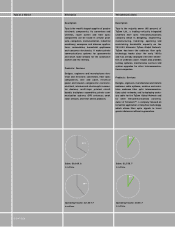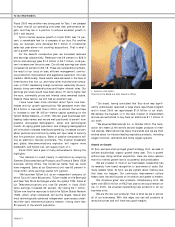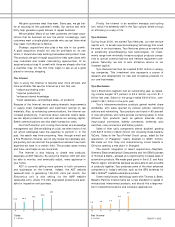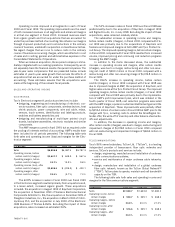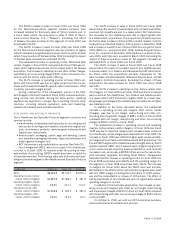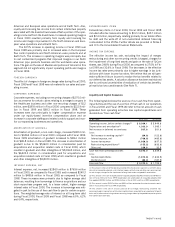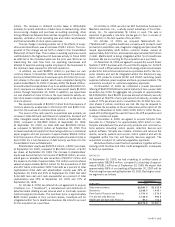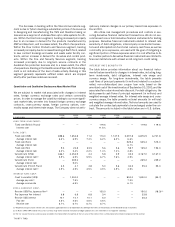ADT 2000 Annual Report Download - page 24
Download and view the complete annual report
Please find page 24 of the 2000 ADT annual report below. You can navigate through the pages in the report by either clicking on the pages listed below, or by using the keyword search tool below to find specific information within the annual report.
TWENTY TWO
Fr
ee
Cas
h Fl
ow
$
in million
s
96
97
98
99
00
1
,
7 2
9
3 ,3 1
2
661
30 9
2 4 2
Stoc
k Pri
ce
(Se
p
tember 30) in dollars
p
er shar
e
96
97
98
99
00
1
0
2
5
––
3 2
2
0
3 3
––
6 4
2 7
5
––
8
5
1
5
––
8
5
1
7
––
8
Tyco Telecommunications
TyCom’s operating income increased 63 percent to $530 mil-
lion, up from $325 million last year. Sales were $2.5 billion,
compared to $1.6 billion in the prior year.
Because Tyco owns 86 percent of TyCom, TyCom’s perform-
ance and growth remain crucial to the Company. TyCom’s build-
out of Phase 1 of the TyCom Global Network, starting from the
U.S. to Europe and then on to Asia, is on schedule and should
begin generating revenues in mid-2001. When complete, the
network will be able to send the equivalent of the entire contents
of the Library of Congress around the world in four seconds.
Clearly, the demand for bandwidth remains voracious. For every
one percent decline in the price of bandwidth, we see demand
grow by two to three percent.
Driving bandwidth demand are the Internet, data transmis-
sion and, increasingly, streaming video. Over the next five years,
traffic under the Atlantic and the Pacific is projected to grow by
120 percent or more per year, and we are well positioned to meet
the growing demand for capacity.
TyCom is definitely part of the Internet infrastructure.
Because it is the industry’s technology leader and the only fully
integrated supplier and owner of undersea fiber optic telecom-
munications systems, it will enjoy a dramatic cost advantage
over its telecommunications services rivals with TGN. Ultimately,
TyCom expects the revenue mix will come predominately from
selling or leasing bandwidth (and providing related services),
while significant contributions will continue to come from con-
struction and maintenance activities.
Maintenance contracts were 200 percent ahead of projec-
tions last year, while the biggest construction contract was the
$1.14 billion C2C AsiaPac system, a 10,600 mile project led
by Singapore Telecommunications that will provide service
between and among the Philippines, Hong Kong, Taiwan, South
Korea, Japan, Singapore and—pending regulatory approval—
China. We sold some of our TGN capacity to C2C in exchange
for capacity on their system, a strategy that will enable us to
extend our global reach through to the essential, rapidly growing
Asian markets.
The TyCom public offering in July was itself an enormous
achievement. We sold 14 percent of TyCom to the public for
$2.1 billion, valuing the entire Company at more than $16
billion, more than 20 times what we paid for most of TyCom just
three years ago.
Tyco Healthcare and Specialty Products
Operating income at Tyco Healthcare and Specialty Products
increased to $1.5 billion, compared to $1.4 billion in the prior
year. Sales grew 13 percent to $6.5 billion, as compared with
$5.7 billion last year.
Almost all of Healthcare’s sales gains came from internal
growth. Growth was especially powerful in international markets,
such as Japan, Asia/Pacific and Latin America. In overseas mar-
kets, we continue to increase our direct sales presence in order
to be closer to our customers. In fiscal 2000, we began selling
direct in Turkey, Israel, Greece, Portugal and Colombia.
Healthcare continued to improve manufacturing margins,
especially at U.S. Surgical. Many new products were introduced
in 2000, but two from Valleylab stand out. Its LigaSure™ vessel
sealing system seals a blood vessel without a suture, while its
CUSA XL is an ultrasonic device that removes brain tumors.
Tyco Healthcare’s size and reputation for quality are helping
it win large contracts with national purchasing groups, while the
bundling of products has recently been very effective at inte-
grated networks (groups of independent hospitals that have
banded together for bulk purchasing). The alternate site market
(nursing homes, outpatient clinics) continues to grow twice as
fast as the hospital market in the U.S., and we are still gaining
market share in this segment.
Tyco Plastics and Adhesives saw its earnings increase 30
percent, an impressive performance in a year when sharply ris-
ing raw material costs could not be completely passed on to our
customers. Ruffies®brand trash bags remain the U.S. market
leader and again gained share in 2000. A new product, wing-tie
Ruffies®bags, was tremendously successful and we are now in
the process of expanding our capacity.
Our garment hanger business remained strong. We make 18
million plastic hangers every business day, or 4.7 billion per
year. That number will likely increase following the introduction
of our highly successful new Pinch-Grip™ hanger, which
replaces hard-to-use models that are difficult to open.
In association with National Football League Associates,
Tyco Adhesives introduced NFL®branded logo bandages, which
are selling well in regional markets throughout the country.
Tyco Fire and Security Services
In Tyco’s Fire and Security segment, operating income increased
13 percent to $1.0 billion, from $907 million last year.
Sales reached $6.1 billion, compared to last year’s $5.5 billion.



